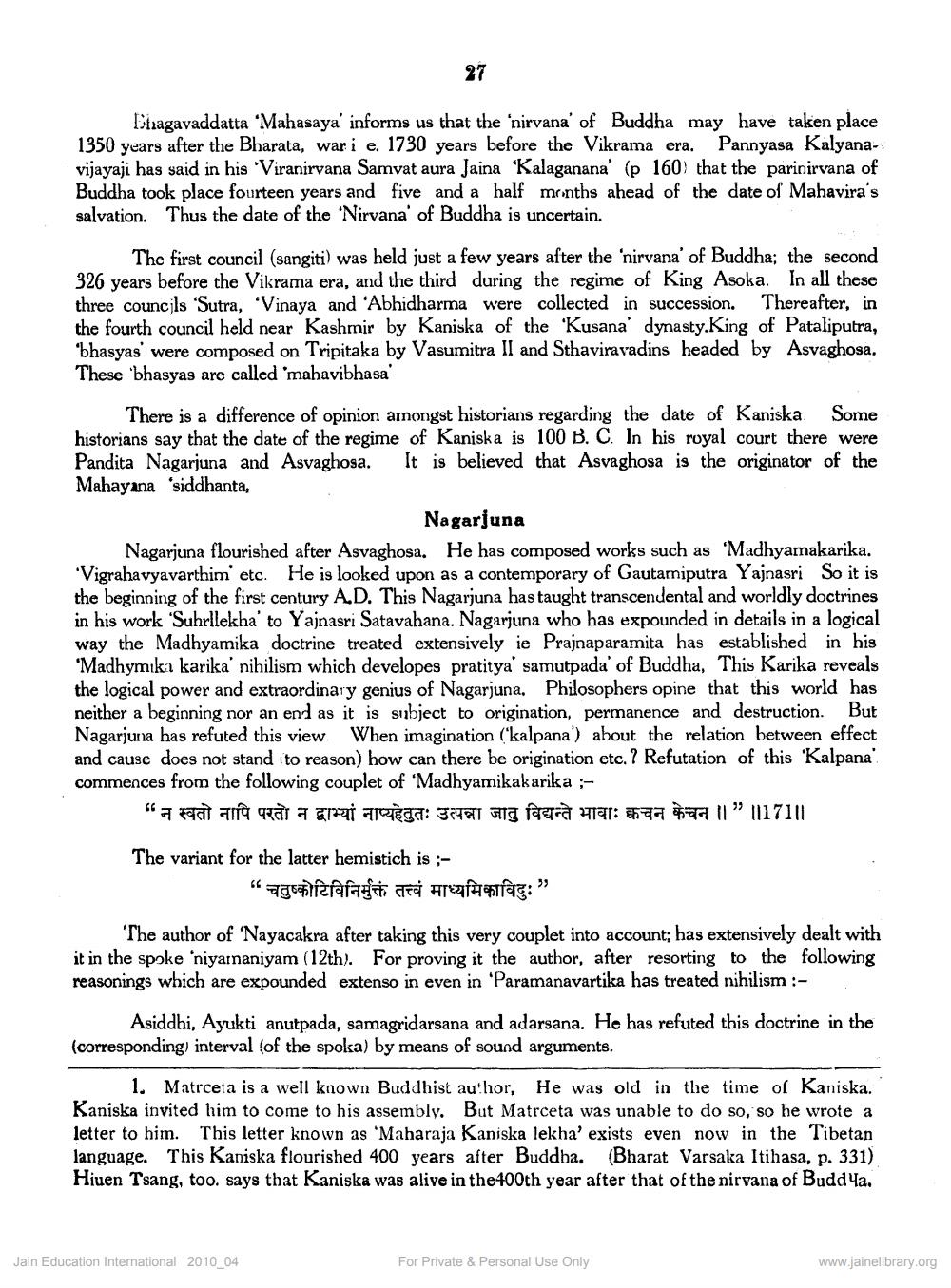________________
Btiagavaddatta Mahasaya' informs us that the 'nirvana' of Buddha may have taken place 1350 years after the Bharata, war i e. 1730 years before the Vikrama era. Pannyasa Kalyanavijayaji has said in his 'Viranirvana Samvat aura Jaina Kalaganana' (p 160) that the parinirvana of Buddha took place fourteen years and five and a half months ahead of the date of Mahavira's salvation. Thus the date of the 'Nirvana of Buddha is uncertain.
The first council (sangiti) was held just a few years after the 'nirvana of Buddha; the second 326 years before the Vikrama era, and the third during the regime of King Asoka. In all these three councils 'Sutra, 'Vinaya and 'Abhidharma were collected in succession. Thereafter, in the fourth council held near Kashmir by Kaniska of the Kusana' dynasty.King of Pataliputra, 'bhasyas' were composed on Tripitaka by Vasumitra II and Sthaviravadins headed by Asvaghosa. These 'bhasyas are called 'mahavibhasa
There is a difference of opinion amongst historians regarding the date of Kaniska. Some historians say that the date of the regime of Kaniska is 100 B. C. In his royal court there were Pandita Nagarjuna and Asvaghosa. It is believed that Asvaghosa is the originator of the Mahayana 'siddhanta,
Nagarjuna Nagarjuna flourished after Asvaghosa. He has composed works such as 'Madhyamakarika. 'Vigrahavyavarthim' etc. He is looked upon as a contemporary of Gautamiputra Yajnasri So it is the beginning of the first century A.D. This Nagarjuna has taught transcendental and worldly doctrines in his work 'Suhrllekha to Yajnasri Satavahana. Nagarjuna who has expounded in details in a logical way the Madhyamika doctrine treated extensively ie Prajnaparamita has established in his "Madhymıka karika' nihilism which developes pratitya samutpada of Buddha. This Karika reveals the logical power and extraordinary genius of Nagarjuna, Philosophers opine that this world has neither a beginning nor an end as it is subject to origination, permanence and destruction. But Nagarjuna has refuted this view When imagination ('kalpana') about the relation between effect and cause does not stand to reason) how can there be origination etc. ? Refutation of this 'Kalpana commences from the following couplet of Madhyamikak arika ;
“a fa ara qat a arat ATTEST: JETET SITT fara war: 7 " 1117111
The variant for the latter hemistich is ;
“qoftraret Ted Arafas: "
The author of 'Nayacakra after taking this very couplet into account; has extensively dealt with it in the spoke 'niyarnaniyam (12th). For proving it the author, after resorting to the following reasonings which are expounded extenso in even in 'Paramanavartika has treated nihilism :
Asiddhi, Ayukti anutpada, samagridarsana and adarsana. He has refuted this doctrine in the (corresponding) interval (of the spoka) by means of sound arguments.
1. Matrceta is a well known Buddhist author, He was old in the time of Kaniska. Kaniska invited him to come to his assembly. But Matrceta was unable to do so, so he wrote a letter to him. This letter known as 'Maharaja Kaniska lekha' exists even now in the Tibetan language. This Kaniska flourished 400 years after Buddha. (Bharat Varsaka Itihasa, p. 331) Hiuen Tsang, too. says that Kaniska was alive in the 100th year after that of the nirvana of Buddha.
Jain Education International 2010_04
For Private & Personal Use Only
www.jainelibrary.org




